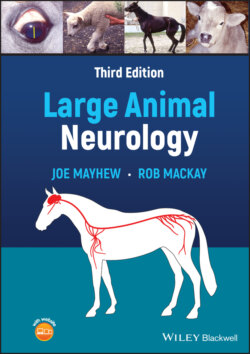Читать книгу Large Animal Neurology - Joe Mayhew - Страница 90
Fungi
ОглавлениеFungal infections of the nervous system are rare (Figure 4.9). The usual result is a mixed neutrophilic and mononuclear inflammation, and granulomata may form. Sometimes immunocompromisation is associated with fungal infections.
Figure 4.7 In distinction from caudal herniation of cerebrum and cerebellum with cerebral and brain swelling (Figures 4.8 and 4.10), occasionally a space occupying cerebellar lesion can cause unusual herniation of brain tissue. This is seen here in a dorsal view of the brain from a yearling heifer that suffered from a rostral cerebellar abscess (situated under the arrow) causing rostral herniation of the cerebellar vermis under the tentorium cerebelli. The position of the removed lateral portions of the tentorium cerebelli is depicted by the yellow bars. Ultimately, the midbrain, with the CN‐III oculomotor nerves beneath, will be compressed ventrally by such herniated tissue.
Figure 4.8 The most frequently seen type of herniation of brain tissues resulting from brain swelling is shown here. This is a caudal view of the occipital lobes and transverse section of midbrain (center), and a median section of the caudal cerebellum (left lower) from a pony that died from leukoencephalomalacia associated with feeding moldy sweet corn. The swollen brain has flattened gyri, and there has been herniation of the ventromedial portions of both occipital lobes caudally (arrows) under the tentorium cerebelli to push ventrally on the midbrain. The right side shows greater herniation resulting in it deviating to the left side and compressing the right side of the midbrain more than that occurring on the left. A further herniation has occurred with the cerebellar vermis being pushed caudally into the foramen magnum producing a bulging of the tonsil of the vermis (arrow head).
Figure 4.9 Septic thromboemboli can lodge in any vessel in the CNS but will often arrive via the major carotid supply and thus seed the forebrain as was the case with this foal suffering from Aspergillus sp. superinfection after neonatal sepsis and abdominal surgery. The necrotic inflammatory lesions seen on this transverse section of the fresh forebrain and midbrain (arrows) are particularly in gray matter that usually has a greater blood supply than white matter.
